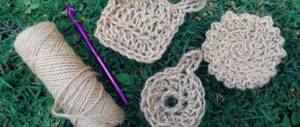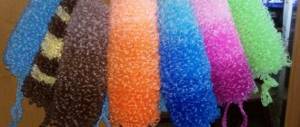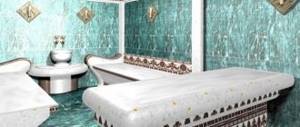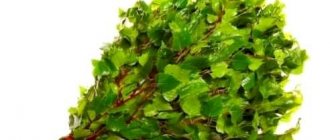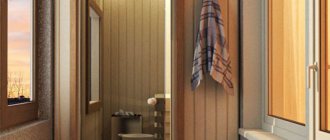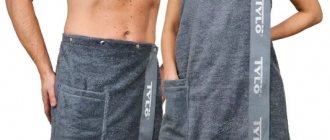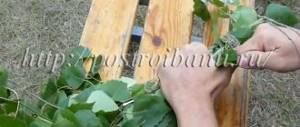A little history and purpose
It is not known for certain when the first devices appeared to help cleanse the skin, but already in references in Babylon and Ancient Greece there is information about the first washcloths. Wealthy people used wood or bronze to wash their skin, while poor people used bunches of plants or sand.
Now, a washcloth is already an absolutely necessary household item for every person. Beautifully designed, of different sizes, colors and purposes, they decorate the bathroom and are indispensable assistants in the bathroom.
A washcloth can be made from any available material: natural cotton or chintz, using old terry towels, woven from burlap, and for those who are not looking for easy ways - knitted.
Where is bast used?
Bast is not just washcloths. From time immemorial, bast was used to weave bast shoes, household utensils, baskets, boxes, and so on...
Lyko became so firmly established in the lives of Russian peasants that it would be difficult to imagine their life without him.
There are quite a lot of proverbs and sayings associated with bast. For example, our everyday saying: “The bast does not knit.” This means that a person is drunk to such an extent that he cannot cope with an ordinary, simple task.
Shoes and household items made from bast were considered a sign of the poor and of simple origin. When they said about a person: “Girded with bast” or “Woe is bast” - this meant that the person lived in poverty.
The bast washcloth is one of the oldest. These are the types of washcloths that have replaced “disposable cleaning agents.”
Kese washcloth
This washcloth is designed to remove dirt from the skin without the use of scrubs and cleansing gels. If a person has sensitive skin, it is made from natural fibers, silk; for coarser skin, it is made from sheep or goat wool.
Its homeland is the East; from ancient times to this day it has been woven in the traditional way - crocheted. First, you need to knit a handle of 40 loops with two threads, on the third, start knitting cap stitches to the end of the chain - the first handle is ready, we make the second in the same way and fasten its end to the first.
The main part of the washcloth consists of three stitches of 16 single crochets, connected to three stitches of 16 double crochets. The washcloth is ready!
It must be thoroughly washed with water and wrung out well to avoid the appearance of various bacteria and unpleasant odors, since the material used in the base does not dry well and retains moisture for a long time.
Knitted bath accessories
To learn how to knit washcloths for a beginner, you need to practice working with knitting needles and threads. You can try three simple schemes:
- Rectangular accessory. Every three rows you need to use elongated loops.
- Round products. To make it fluffy and neat, you need to knit a washcloth with one loop. For originality, you can use threads of different colors that are woven into the base.
- Oval accessories. The scheme is similar to rectangular. Every three rows you need to use elongated loops.
Burlap washcloth
If you don’t know how to knit or don’t want to, you can make a beautiful washcloth with your own hands using burlap, for this you will need: burlap, foam rubber or sponge, gauze, soap and elastic, and also a piece of cotton fabric.
From burlap you need to cut two identical rectangles slightly larger than your palm, and the same ones for the gauze lining. A holder for a bath accessory is made using an elastic band, assembled like an accordion and covered with fabric. One end is secured in the middle of a burlap rectangle, and the other is sewn to the side.
Next, the burlap is sewn together to form a bag and pieces of soap and a sponge are placed in it to create foam; dried lavender or mint can be added for scent. The washcloth needs to be sewn up. It is ready to use. When the soap in it stops foaming, you will need to rip it open and pour in a new portion.
Bast washcloth and delicate skin
If you are a fan of rich foam, soft, gentle washing, you are unlikely to like this natural washcloth. It will also not cause great delight among small children.
A bast for those who like to rub their skin until it’s red and squeaky clean.
If you have been actively sunbathing and have acquired an incomparable bronze skin color, do not use a bast washcloth - use fluffy soft sponges. And when the turn of autumn and winter cold comes, then you can use a bast washcloth to disperse the blood!
To combat the eternal female problem (cellulite), there is no better option than a bast washcloth. Natural rigidity is an ally in breaking up unnecessary deposits on the hips.
This is the bast washcloth that Mother Nature and the beautiful linden gave us. If you don't believe me, try it yourself! Good luck to you!
Mesh washcloth
A washcloth can also be constructed from a mesh, which can be purchased in any bathroom department of a large hardware supermarket or at a bazaar.
To do this, you need to form a bag out of it, insert pre-cut foam rubber and fix it on top. The sponge will create a thick foam that can cleanse pores and give freshness to the skin.
What is bast
Bast is the inner fibrous side of the linden bark, that is, its fragile subcortical part.
The top layer of linden bark is peeled off and the resulting thin light material is cut into thin strips, from which a natural bath attribute is obtained.
But not only linden bast is used to make washcloths. You can use the bast of any young deciduous tree for the loofah.
Polypropylene washcloth
To knit such a bath “helper”, it is enough to purchase the appropriate threads and a hook size 5-6 with a round head. Initially, you need to knit a chain of loops 20 cm long and connect them into a ring.
Next, you need to knit the main fluffy part of the washcloth using the “DC” method and finish with several rows of “SC”, and at the end knit the handles. This way you can knit a washcloth from any material.
When is the best time to harvest bast?
It is best to prepare the future washcloth from bast in the spring. At this time, the tree is gaining spring sap, its bark is tender and soft. But when it dries, it coarsens, becomes hard and tough.
Therefore, when the bast is cut, it is soaked in water to make it more soft and flexible.
Then the strips are collected into a bundle, which can be tied - this is how you get a washcloth. Agree, everything is quite simple...
Results
If you look at examples of photos of do-it-yourself washcloths in books, brochures, craft magazines or on the Internet, you will see what a variety of these bath items there are. In addition to the original accessory, spending a minimum of time and effort, you will receive a real decoration for the bathroom, an indispensable cleanser suitable for your skin and save money.
Such washcloths can be given as a gift or an addition to a gift, or they can also be sewn for children in the form of various animals or cartoon characters. The child will be more willing to bathe with such a gift.
Synthetics and organics: the eternal struggle
Bath sponges, in theory, should consist only of fibers from natural raw materials, because the bath, as we never tire of repeating, is a stronghold of everything real and environmentally friendly. But what to do when modern science, followed by industry, throws more and more new types of synthetic products onto the market, and sellers vying with each other to praise the new products, tempting the consumer with hitherto unprecedented innovations. Let's evaluate such products with passion, maybe we'll find something?
Synthetic washcloths: do they have a place on the bath shelf?
Many adherents of industrial theory firmly believe that chemists do not eat bread in vain. And if there is such a fundamental thing for a real Russian bath as synthetic vodka, then a synthetic washcloth is such a trifle that it’s not even worth mentioning, it’s already a given. What types of them can we find on store shelves and market stalls:
- Foam sponges. They have a very delicate, soft texture, perfectly absorb detergents and generate foam. They have a wide variety of shapes, colors and porosity of the massif. However, a delicate surface requires no less delicate handling. Excessive efforts cause increased wear of such a bath sponge, and excessive softness of the surface does not always contribute to high-quality cleansing of the skin surface. Children's washcloths made of foam rubber are very popular. At the same time, it is necessary to thoroughly dry such products after use, otherwise they are prone to souring due to good moisture retention.
- Polyethylene washcloths. They are long products woven from polyethylene fiber with handles - for comfortable back washing. Due to their more developed contact surface, they have better cleansing properties, however, they can cause irritation of delicate and sensitive skin. A high-quality washcloth should have a uniform and uniform surface, but inexpensive products, unfortunately, cannot boast of such properties.
- Washcloths are roses made of nylon or nylon thread. A real find for a bathhouse, which is very difficult and takes a long time to ventilate. Due to the amorphous and inert nature of the material with a very low coefficient of water absorption, they dry very quickly and efficiently. Compact, lightweight, easily restores its original shape after deformation. However, if you protect them from contact with very hot objects, the thread is destroyed due to lightning-fast melting. Frankly cheap products made by Chinese “masters” are prone to loss of shape due to breaks in the connecting, so-called “load-bearing” frame threads.
- Washcloths towels made of polyester fabric. They entered the market in the late 1950s thanks to the growing power of Japanese industry. Due to the weaving pattern and diameter of the thread, their rigidity can vary widely and, as a result, a massage effect is present to one degree or another. Branded products are durable and practical to use, but are quite expensive to purchase.
Connoisseurs, experts and other analysts like to talk at length about the dangers of synthetic fibers, citing as an argument the increased allergenicity of the material, dyes and the ability of synthetic fibers, in conditions of elevated temperature and humidity, to release harmful substances into the indoor atmosphere. Undoubtedly, these arguments cannot be denied, however, a categorical statement about the dangers of a particular product can only be done with comprehensive data from an in-depth comprehensive examination.
Toys and mittens made of polypropylene thread
These artificial materials, from which various shower sponges are most often knitted, are convenient because they are quite easy to work with. The thread does not fluff for obvious reasons and does not get tangled, so it is easy to handle both with crochet and knitting needles. Another positive factor of polypropylene yarn is the wide range of colors. Using this material it is very convenient to knit multi-colored washcloths or bath accessories in the form of toys. The latter are especially popular with children.
You need to knit from polypropylene with knitting needles and crochet no finer than number four or even number five. This thread is quite stiff, and therefore it is advisable not to pull it very tightly, since a washcloth that is too coarse is not suitable for use. Moreover, you need to be especially scrupulous about this issue if you plan to knit a washcloth for a child. Therefore, do not rush to start working right away, but first knit several test rows with knitting needles or crochets of different sizes to find the most suitable knitting density.
If you decide to knit with polypropylene threads using a hook, then choose a tool model with a rounded head. A sharp end can disrupt the structure of the thread, breaking it.
Polypropylene makes beautiful washcloths in the shape of a hedgehog toy. To do this, you will need threads of two different colors: darker - to create its needles and lighter - for the muzzle. You need to crochet a hedgehog with elongated loops as follows.
- Cast on 20 cm of loops with a dark thread, connect them into a ring and knit two rows with single crochets.
- Make several rows of elongated loops: pull out the loops two to three centimeters long and remove them from the hook, knitting the loops through one stitch.
- Knit with elongated loops 10 centimeters in height.
- Next, use light threads to knit the cone-shaped face of the animal.
- Knit according to this pattern - two single crochets, then skip the next loop and two double crochets again - so that the knitting begins to taper.
- Knit in this way until all the loops come together.
- Make the nose and eyes of the animal from black thread - and the washcloth is ready.
In addition, you can make a knitted washcloth in the shape of a mitten from polypropylene thread, which will be not only beautiful, but also a convenient bath accessory. Two identical parts of the product are knitted. First of all, you need to crochet 20 loops and knit five rows with single crochets. Then, to knit a finger at the end of the row, you should cast on eight air loops and tie them with double crochets. Return to the main fabric and knit five more rows with single crochets, then begin to cut the loops, rounding the top of the mitten. To do this, do not knit one stitch from each edge of the knitting until the mitten is completely rounded. Complete the second part of the product in the same way and sew the finished halves together.
Natural washcloths - types, benefits, how to choose
Synthetic sponges have gained immense popularity in their time - they are soft, gentle, easy to clean and dry quickly. But the fashion for environmentally friendly things dictates its own and natural washcloths are increasingly attracting people’s attention. And this is not surprising, because they have a number of advantages: they exfoliate and cleanse the skin better, improve microcirculation, and they are completely biodegradable.
Eco-scrubbers are made from natural plant fibers that vary in softness.
- For gentle exfoliation, you can use a loofah sponge with a long handle - it can be used to conveniently massage the skin of your back.
Loofah is a natural material, the softness of which is determined by the size of the cells. If they are large, the washcloth is hard. Therefore, for children and people with sensitive skin, choose fine-mesh options.
- The second softest eco-loofah is made of nettle fiber.
It is already somewhat rougher than loofah and more intensively cleanses the skin of dead cells. In the old days, nettle was one of the most popular materials for making washcloths and even fabric. It works great on steamed skin - try using it in a sauna or after a bath. The result will surprise you!
- Next comes jute. The most convenient option is a “Mitten” washcloth, woven from jute fiber.
It is already noticeably tougher, and the weaving adds scrubbing properties to it. The glove perfectly cleanses and massages the body, improves blood circulation and helps in the fight against cellulite.
- For those who like hard exfoliation or, if necessary, to wash away dirt that tends to eat in, a sisal strip and bast washcloth are suitable.
Such a hard peeling will remove all dead cells, sebaceous plugs and unevenness on the skin - it becomes smooth and very clean! The excellent massage properties of bast and sisal help in the fight against cellulite, smoothing out the “orange peel” and making your silhouette clearer.
In order for natural washcloths to be beneficial and last a long time, you need to use and care for them correctly. You can use them no more than 2 times a week so as not to injure your skin - even the softest eco-washcloth is tougher than a synthetic sponge. The skin should be well warmed and moisturized, ideally in a bathhouse or sauna. But a warm bath or hot shower is fine. After such peeling, cream or moisturizing milk must be applied.
After use, the washcloth must be thoroughly washed with soap and dried in a dry and warm place, for example, on a radiator. This is necessary so that the natural fiber does not deteriorate from moisture and bacteria do not multiply in it.
Natural eco-scrubbers, when used correctly, help to effectively cleanse the skin, fight cellulite and preserve nature. After all, they are made from easily renewable natural materials that do not pollute the environment and are safe for your health.
